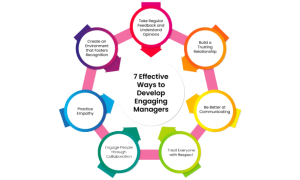7 Effective Ways to Develop Engaging Managers

Managers who create engaging work environments have a positive impact on employees. Studies show that about 49% of disengaged employees list problems with their supervisors as their reason for disengagement. Moreover, an indifferent employee does not care what they do means to the organization’s success.
According to studies, employee engagement is largely influenced by managers. A productive workplace requires good relationships between employees and their supervisors. Such relationships are crucial for an organization’s success. Therefore, engaging managers are vital for your business to prosper.
As opposed to disengaged employees, engaged employees are passionate advocates for the brand. Gallup estimates that engaging managers are responsible for about 70% of the variance in employee engagement. Several engagement strategies help managers to achieve higher levels of performance. This technique is being used by managers to boost employee engagement.
Rather than letting your disengaged managers go, consider these methods to create engaging managers. Also, motivate employees and managers to increase organizational growth.
1. Build a Trusting Relationship:
Developing mutual trust among your team members is essential for the success of your organization. One in three employees trust their leaders deeply, while 50% believe HR is not trustworthy.
Whether working in person or remotely, trust is essential. Without it, an employee is likely to be less motivated and productive. 80% of employees with a higher level of trust in their management are more committed to their work. High-trust companies have on average 74% fewer stress issues, 50% higher productivity, and 40% lower burnout among workers.
2. Be Better at Communicating:
Working in the workplace can be challenging if communication isn’t effective. Communication within a workplace is effective when the workplace environment is positive. Several studies have found that companies value communication skills two times more than managerial skills.
In order to achieve your business goals, communication needs to improve from the top. Communication skills at work are often what separates a good leader from an excellent one. Communication within the workplace helps coworkers collaborate and defines organizational goals. This is a fundamental step towards a committed and productive workforce.
3. Treat Everyone with Respect:
Respect for someone is a feeling of treating them well for their qualities or characteristics. Respect can also refer to people’s dignity. Workplaces need respect because it encourages employees to work hard. When employees know their efforts are appreciated, they are more likely to strive for excellence. Team members should respect their managers and colleagues’ work, even if they don’t necessarily appreciate their personalities or think highly of them.
4. Engage People through Collaboration:
Two or more people worked together to accomplish a goal through collaboration. Communication can take place either in person or virtually, thanks to several communication tools and cloud-based programs that are available for such purposes.
Employees feel safe, noticed, and heard when working with engaging managers. They will run efficient meetings and work sessions. Likewise, it is also crucial to engage employees at the workplace. The engaged managers realize the importance of team communication and follow standardized collaboration practices.
5. Practice Empathy:
Empathy at work means showing genuine interest in others’ situations and setting up a hierarchy that is tolerant of conflict and compromise.
A variety of workplace factors can interfere with your people’s ability to understand and share emotions with their teammates, including stress, deadlines, and distractions. As a result, employers find it difficult to demonstrate empathy for their employees, thereby hindering them from unlocking their teams’.
To foster a healthy workplace, people and culture professionals must recognize and promote the value of empathy at work.
6. Create an Environment that Fosters Recognition:
Gallup reported that over the last 12 months, 65% of surveyed employees did not receive any recognition for their work. 89% of employers said most employees leave their companies in order to earn more income. However, lack of employee recognition is a major concern among those leaving their jobs.
As a company, when you show employees that their efforts are making a measurable difference to your business and your community. Those employees feel good about what they do, which causes them to feel good about their work.
7. Take Regular Feedback and Understand Opinions:
Conducting feedback surveys, such as 360-degree feedback and eNPS (Employee Net Promoter Score), allows you to determine engagement levels and areas of strength and weakness. Create engaging managers by taking action that matters.
If you haven’t taken 360-degree feedback, you can take our simple and effective 360-degree feedback to build a happier, more productive, and engaged workforce.
Conclusion:
With these proven methods, you can implement an engaging environment in your organization and make the organization successful. To that end, it is imperative to keep engaging managers and employees in an organization to achieve greater performance.
Opt for QaizenX’s Employee Engagement Software!
Recent Posts
- 20 Examples Of Employee Feedback In The Workplace
- How to Obtain Valuable Input from Your Audience for Enhanced Product Development (and Increased Sales)
- 4 E’s of Employee Engagement and How To Implement Them
- How To Choose The Right Customer Experience Management Software For Your Business
- Why Customers Leave: Recognizing the Signs and Strategies for Retention




